Click On Image
For Full Size Image |
Size |
Image Description |
Contributed
By And/Or Copyright |
Name
|

NS0306312 |
101k |
CVE-63 was initially named Chapin Bay for a bay
in Alaska, on the southeast coast of Admiralty Island, Alexander Archipelago (the bay was named in
1892 by LT William Irwin Moore, USN, in command of the U.S. Coast Guard and Geodetic Survey steamer
Patterson, for ENS Frederick Lincoln
Chapin, USN, a member of his party). (NS0306312).
Renamed Midway, 3
April 1943 (prior to launching), after the battle (3–6 June 1942) in which the U.S. Pacific Fleet
turned back a Japanese attempt to capture Midway, the westernmost atoll in the Hawaiian chain, in a
decisive action which cost the enemy four large aircraft carriers and forced Japan to assume a defensive
posture (NS0306312a–NS0306312d, NS024196.) A previous
Midway had been named for the
atoll itself.
On 10 October 1944 CVE-63 was renamed St. Lo, to free the name Midway
for CVB-41, one of the "Large Carriers" then
under construction. The new name commemorated an important victory of American troops in France, that
captured the strongly defended town, Saint-Lô, 18 July 1944. (NS0306312b,
NS0306312c.)
(Maps NS0306312, NS0306312a, NS0306312b
and NS0306312d courtesy of Google Maps.
Photo NS024196 U.S. Navy. Photo NS0306312c courtesy
of Conseil régional de Basse-Normandie and US
National Archives.) |
NavSource |

NS0306312a |
10k |

NS0306312d |
19k |

NS024196 |
191k |

NS0306312b |
96k |

NS0306312c |
184k |

NS020551 |
74.8Mb |
"The Battle of Midway," directed by John Ford and narrated by Henry
Fonda, is comprised mostly of authentic footage from the battle. This documentary, produced in 1942,
won an Academy Motion Picture Arts and Sciences Award (Oscar). Then Commander (later Rear Admiral)
John Ford, USNR, in civil life wrote, directed or produced more than 130 films in a career spanning
four decades.
Format: MP4 (.mp4) Duration: 18' 7" Size: 320 x 240
Download a free
MP4 player. |
Courtesy of Internet Archive. Thanks
to Ron Reeves
for the clue. |
As USS Midway (CVE-63)
|
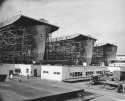
NS0306314 |
602k |
Three escort carriers under construction at the Kaiser Shipbuilding Co., Vancouver
yard. Left to right: Kaiser hull # 309, the future USS Midway (CVE-63); hull # 308, slated
to be HMS Begum but completed as USS Natoma Bay (CVE-62); and hull
# 307, the future USS Manila Bay (CVE-61). April–August 1943. |
Tim Smith |
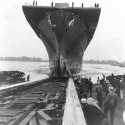
NS0306304 |
30k |
The Midway being launched on August 17, 1943. |
USS Saint Lo Association |

NS0306303 |
38k |
USS Midway (CVE-63) leaving Astoria, Ore., on Nov. 13, 1943.
Photo taken from USS Tripoli (CVE-64). |
USN |

NS0306305 |
60k |
The Midway somewhere in the Pacific on the way to Australia with
a load of aircraft. |
USS Saint Lo Association |
As USS St. Lo (CVE-63)
|

NS0306301 |
71k |
San Diego, April 1944. Camouflaged in Measure 32, Design 15A. National Archives
photo # 80-G-47028. |
Tracy White, Researcher @ Large |
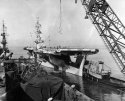
NS0306302 |
625k |
USS St. Lo (CVE-63) leaving the destroyer base at San Diego,
10 April 1944, as seen from USS White Plains (CVE-66).
National Archives and Records Administration
(NARA) photo, # 80-G-384078. |
NARA |
Battle off Samar, 25 October 1944
|

NS0306307 |
34k |
USS St. Lo (previously believed to be the Gambier
Bay) and DE laying down a smokescreen on October 25, 1944 during the Battle off Samar. |
USS Saint Lo Association |

NS0306306a |
112k |
A Zeke, as seen from White Plains [(CVE-66), ]
hitting the escort carrier USS St. Lo (CVE-63). The kamikaze approached from
astern, dropping its bomb which penetrated the flight deck aft, before hitting amidships at a shallow
angle, igniting its fuel tanks. This explains the streak of flame shooting upwards and forward from
the point of impact. The 20-mm gun in the foreground has been fitted with a Mk.14 lead-computing gun
sight that used a pair of gyroscopes to extrapolate an aiming point from the gun's previous movements.
Photo from NARA (National Archives and Records Administration) facility College Park, MD.
Photo and text from Fire From The Sky,
by Robert C. Stern. |
Robert Hurst |

NS0306306 |
550k |
USS St. Lo (CVE-63) burns after being hit by a Kamikaze
on 25 October 1944. This photograph was taken from USS Kalinin
Bay (CVE-68).
Official U.S. Navy Photograph, now in the collections of the National
Archives and Records Administration (NARA), # 80-G-270511. |
Gerd Matthes, Germany
NARA |

NS0306306b |
87k |
[Cropped copy of photo NS0306306]. St. Lo
as seen from Kalinin Bay probably less than two minutes after the kamikaze
hit. St. Lo's crew can be seen fighting the fire on the flight deck, which fortunately
had been clear awaiting a returning strike. This fire was rapidly brought under control. Photo from
NARA (National Archives and Records Administration) facility College Park, MD.
Photo and text from Fire From The Sky,
by Robert C. Stern. |
Robert Hurst |
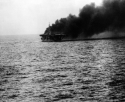
NS0306306d |
662k |
USS St. Lo (CVE-63) burning after being hit by a Japanese suicide
plane off Leyte Gulf, Philippines, 25 October 1944. Taken from USS Kalinin Bay
(CVE-68).
National Archives and Records Administration (NARA), photo
# 80-G-270512. |
NARA |
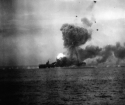
NS0306306e |
981k |
USS St. Lo (CVE-63) burning after being hit by a Japanese suicide
plane off Leyte Gulf, Philippines, 25 October 1944. Taken from USS Kalinin Bay
(CVE-68). This view shows the moments after the second explosion.
National Archives and Records Administration (NARA), photo
# 80-G-270513. |
NARA |

NS0306306j |
203k |
USS St. Lo (CVE-63) hit by a Japanese suicide plane off Leyte
Gulf, Philippines, 25 October 1944. Taken from one of the accompanying ships. |
Tim Smith |

NS0306306f |
387k |
USS St. Lo (CVE-63) burning after being hit by a Japanese suicide
plane off Leyte Gulf, Philippines, 25 October 1944. Taken from USS Kalinin Bay
(CVE-68). This picture shows sailors viewing the moments after the second explosion.
National Archives and Records Administration (NARA), photo
# 80-G-270514. |
NARA |
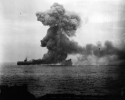
NS0306306g |
499k |
USS St. Lo (CVE-63) shown immediately after being hit by a Japanese
suicide plane off Leyte Gulf, Philippines, 25 October 1944. Taken from USS Kalinin
Bay (CVE-68).
National Archives and Records Administration
(NARA), photo # 80-G-270515. |
NARA |
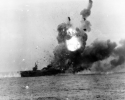
NS0306308 |
610k |
At about 1055 a major detonation (probably caused by a pair of torpedoes
lying almost in the center of a fire started a few minutes earlier by a kamikaze hit) destroyed
much of the after section of the flight deck. The after elevator blew upward and disappeared, some
25' of the flight deck were folded forward and the forward elevator was warped. The explosion also
knocked out steering control.
Official U.S. Navy Photograph, now in the collections of the National
Archives and Records Administration (NARA), # 80-G-270516. |
USS Saint Lo Association
Robert Hurst
NARA |
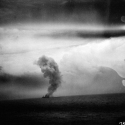
NS0306306h |
362k |
USS St. Lo (CVE-63) burning after Japanese fighter made suicide
dive onto the flight deck during the Battle of Leyte Gulf, 25 October 1944. As seen from USS Kitkun
Bay (CVE-71).
National Archives and Records Administration
(NARA), photo # 80-G-287510. |
NARA |
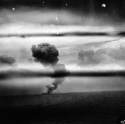
NS0306306c |
348k |
The now doomed St. Lo as seen from Kitkun
Bay [(CVE-71)]. Another massive explosion followed the first and several more followed this
one. Within a half-hour, the escort carrier rolled over and sank, the first of 66 ships lost to the
Tokkotai (Special Attack Units).
National Archives and Records Administration
(NARA), photo # 287511.
Text from Fire From The
Sky, by Robert C. Stern. |
Robert Hurst |

NS0306306i |
408k |
Japanese planes sink the escort carrier USS St. Lo (CVE-63)
during the Battle of Samar off the Philippines, 25 October 1944. Photograph released 14 November 1944.
National Archives and Records Administration
(NARA) photo, # 80-G-47041. |
NARA |
Photos submitted by Tim Smith
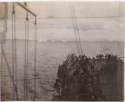
NS0306306k
26 Kb
|
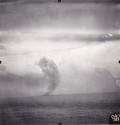
NS0306306l
227 Kb
|
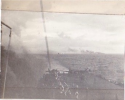
NS0306306m
21 Kb
|
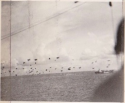
NS0306306n
22 Kb
|
|
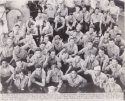
NS0306315 |
281k |
"W-391-11/18—Members of the crew of the escort carrier St. Lo,
sunk by Jap planes in the Battle of the Philippines, make a victory sign on the deck of a rescue ship,
shortly after the battle. Marine Corps photo by [.......]" |
Tim Smith |

NS0307016a |
177k |
THE SECRETARY OF THE NAVY
WASHINGTON
The President of the United States takes pleasure in presenting the PRESIDENTIAL UNIT CITATION to
the
TASK UNIT SEVENTY-SEVEN POINT FOUR POINT THREE, consisting of the U.S.S. FANSHAW
BAY and VC-68; U.S.S. GAMBIER BAY and VC-10; U.S.S. KALININ
BAY and VC-3; U.S.S. KITKUN BAY and VC-5; U.S.S. SAINT LO and VC-65;
U.S.S. WHITE PLAINS and VC-4; U.S.S. HOEL;
U.S.S. JOHNSTON; U.S.S. HEERMAN;
U.S.S. SAMUEL B. ROBERTS; U.S.S. RAYMOND;
U.S.S. DENNIS and U.S.S. JOHN
C. BUTLER
for service as set forth in the following
CITATION:
"For extraordinary heroism in action against powerful units of the Japanese Fleet
during the Battle off Samar, Philippines, October 25, 1944. Silhouetted against the dawn as the Central
Japanese Force steamed through San Bernardino Strait toward Leyte Gulf, Task Unit 77.4.3 was suddenly
taken under attack by hostile cruisers on its port hand, destroyers on the starboard and battleships
from the rear. Quickly laying down a heavy smoke screen, the gallant ships of the Task Unit waged battle
fiercely against the superior speed and fire power of the advancing enemy, swiftly launching and rearming
aircraft and violently zigzagging in protection of vessels stricken by hostile armor-piercing shells,
anti-personnel projectiles and suicide bombers. With one carrier of the group sunk, others badly damaged
and squadron aircraft courageously coordinating in the attacks by making dry runs over the enemy Fleet
as the Japanese relentlessly closed in for the kill, two of the Unit's valiant destroyers and one destroyer
escort charged the battleships point-blank and, expending their last torpedoes in desperate defense
of the entire group, went down under the enemy's heavy shells as a climax to two and one half hours
of sustained and furious combat. The courageous determination and the superb teamwork of the officers
and men who fought the embarked planes and who manned the ships of Task Unit 77.4.3 were instrumental
in effecting the retirement of a hostile force threatening our Leyte invasion operations and were in
keeping with the highest traditions of the United States Naval Service."
For the President,
James Forrestal
Secretary of the Navy |
Thanks to Gerry Lawton, CDR USN (Ret.) |
The Crew
|

NS0306309 |
62k |
Rear Admiral Francis Joseph McKenna was born on 19 March 1898, graduated
from the Naval Academy in 1920 with the class of 1921A, and got his Navy Wings in 1926. Promoted to
Captain in June 1942, at the end of his assignment in the Aleutians in April 1943 he was ordered as
the Prospective Commanding Officer of the escort carrier USS Midway.
In 1944 Midway was renamed St. Lo, thereby freeing the name for one
of the "Large Carriers" then under construction. Just one year after her commissioning, on 25 October
1944, St. Lo was a member of "Taffy 3" at the Battle
of Leyte Gulf, the largest naval battle in history. The ship came through the surface engagement with
the Japanese battle fleet unscathed, but shortly afterwards was hit by a kamikaze and sank,
the first US ship to be sunk by a Japanese suicide attack. Captain McKenna, the last man to leave
his doomed ship, was awarded the Navy Cross for conspicuous gallantry in action.
Still as a Captain, Francis J. McKenna was the first commanding officer of the aircraft carrier
USS Kearsarge (CV-33), in 1946–47.
In addition to the Navy Cross (second only to the Medal of Honor), Admiral McKenna was awarded the
Bronze Star with Combat "V," and the Legion of Merit. Additionally, and of great pride to him, he
was authorized—with the rest of the crew of St. Lo and Composite Squadron (VC)
65—to wear the Presidential Unit Citation for the magnificent job performed by ship and men at
Leyte Gulf as a unit of "Taffy 3" (TU 77.4.3).
Photo courtesy of the United States Navy. |
Bill Gonyo |

NS0306309a |
207k |
Painting, oil on board, by William F. Draper, 1942, of Captain Francis J.
McKenna, Senior Naval Officer present at the occupation of Amchitka. He wears typical winter gear of
the Aleutians. A fur-lined parka and the green garrison of a Navy pilot. |
Tim Smith |

NS0306317 |
304k |
"SEATTLE, DEC. 7[, 1944]—A quiet game of checkers. Survivors of the
escort carrier St. Lo, lost in the Second Battle of the Philippines, enjoy a game of
checkers. (L-R) Joseph Borst, F2/c; William Barton, S2/c; Robert Schreiver, S1/c all of Chicago. 350
survivors arrived here. (APWIREPHOTO)" |
Tim Smith |

NS0306313 |
413k |
Glen Osborn, a USS St. Lo (CVE-63) veteran, speaks at a donation
event commemorating the Battle of Samar at the National Museum of the U.S. Navy, Washington, 14 July
2021. St. Lo was one of the escort carriers that comprised Task Unit 77.4.3, call sign
Taffy 3. During the Battle of Samar, St. Lo was struck by a kamikaze becoming the
first major ship sunk by a Japanese suicide attack. Naval
History and Heritage Command, located at the Washington Navy Yard, is responsible for the preservation,
analysis, and dissemination of U.S. naval history and heritage.
U.S. Navy photo by Mass Communication Specialist
2nd Class Randy Lee Adams II (# 210714-N-WZ681-1073). |
USN |

NS0306313a |
449k |
Naval History and Heritage
Command (NHHC) Director Samuel J. Cox and Glen Osborn, a USS St. Lo (CVE-63) veteran,
shake hands during a donation event commemorating the Battle of Samar at the National Museum of the
U.S. Navy, Washington, 14 July 2021.
U.S. Navy photo by Mass Communication Specialist
2nd Class Randy Lee Adams II (# 210714-N-WZ681-1091). |
Memorabilia
|

NS0306316 |
1.08M |
Trusty Shellback Certificate for S1/c Joseph M. Weatherwax, USS Midway
(CVE-63), 14 January 1944.
Joseph survived the sinking of the ship. |
Tim Smith |
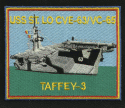
NS0306310 |
208k |
USS St. Lo (CVE-63)/VC-65.
Taffey(sic)-3. |
Tommy Trampp |

NS0306311 |
94k |
Set of four USS Midway/St. Lo (CVE-63) and Composite
Squadron (VC) 65 Reunion pins. |
Tommy Trampp |
For more photos and information about this ship, see:
|












































